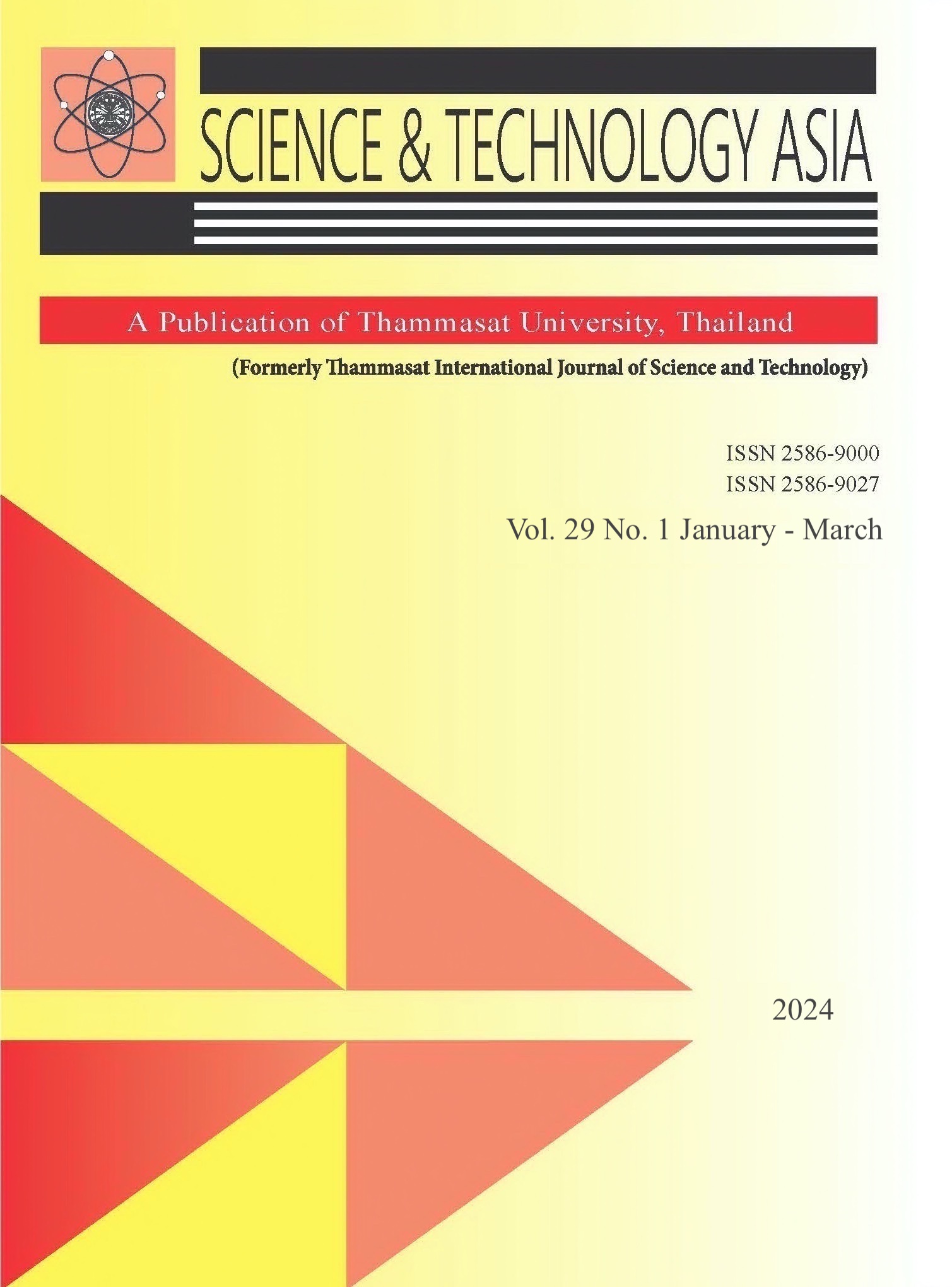Cellulose Extraction from Sisal Fibers and Thermo-Chemical Characterization for Sustainable Industrial Applications
Main Article Content
บทคัดย่อ
The research on cellulose extraction from sisal fibers and its application in industry is an important field of study, especially with regard to the creation of environmentally friendly materials. The aim of this particular study was to utilize natural fiber waste and promote sustainability by extracting cellulose from sisal fibers. Several analytical methods, such as EDX, TGA, DSC, and tensile testing, were used to evaluate the properties of the extracted cellulose fibers. The results show that the extracted cellulose was thermally stable and had good mechanical properties, making it suitable for various industrial purposes. The use of natural fiber waste as an alternative to synthetic materials is receiving increasing attention due to its potential to reduce the environmental impact and promote circular economy practices. This study contributes to the growing body of research on sustainable materials and highlights the potential of using natural fiber waste in industry. Additionally, it provides insights into the potential use of sisal fibers in other areas, such as biodegradable packaging materials, textiles, and medical applications. The development of sustainable materials is crucial in addressing environmental challenges and promoting sustainable development, and this study provides valuable insights into the use of natural fibers as an environmentally friendly alternative to synthetic materials.
Article Details

อนุญาตภายใต้เงื่อนไข Creative Commons Attribution-NonCommercial-NoDerivatives 4.0 International License.
เอกสารอ้างอิง
Y. Liu et al. A review of cellulose and its derivatives in biopolymer-based for food packaging application. Trends Food Sci. Technol. 2021;112:532-46.
H. Seddiqi et al. Cellulose and its derivatives: towards biomedical applica-tions. Cellulose. 2021;28(4):1893-931.
T. Aziz et al. A review on the modification of cellulose and its applications. Polymers (Basel) 2022; 14(15):3206.
S. Fischer, K. Thümmler, B. Volkert, K. Hettrich, I. Schmidt, and K. Fischer. Properties and applications of cellulose acetate. Macromol. Symp. 2008;262(1): 89-96.
N. Grishkewich, N. Mohammed, J. Tang, and K.C. Tam. Recent advances in the application of cellulose nanocrystals. Curr. Opin. Colloid Interface Sci. 2017; 29: 32-45.
S. Mishra, A.K. Mohanty, L.T. Drzal, M. Misra, and G. Hinrichsen. A review on pineapple leaf fibers, sisal fibers and their biocomposites. Macromol. Mater. Eng. 2004;289(11): 955-74.
P. Samyn. Wetting and hydrophobic modification of cellulose surfaces for paper applications. J. Mater. Sci. 2013;48(19):6455-98.
N.A. Bhimte and P.T. Tayade. Evaluation of microcrystalline cellulose prepared from sisal fibers as a tablet excipient: a technical note. AAPS PharmSciTech. 2007:8(1):8.
R.S. Baghel, C.R.K. Reddy, and R.P. Singh. Seaweed-based cellulose: Applications, and future perspectives. Carbohydr. Polym. 2021;67(118241): 118241.
A. Sharma, M. Thakur, M. Bhattacharya, T. Mandal, and S. Goswami. Commercial application of cellulose nano-composites- A review. Biotechnol. Rep. (Amst.). 2019;21(e00316):e00316.
S. Ge, L. Zhang, Y. Zhang, F. Lan, M. Yan, and J. Yu. Nanomaterials-modified cellulose paper as a platform for biosensing applications. Nanoscale. 2017;9(13):4366-82.
F. Fan et al. Extraction and characterization of cellulose nano whiskers from TEMPO oxidized sisal fibers. Cellulose. 2022;29(1):213-22.
T.G. Ambaye, M. Vaccari, S. Prasad, E.D. van Hullebusch, and S. Rtimi. Preparation and applications of chitosan and cellulose composite materials. J. Environ. Manage. 2022; 301(113850): 113850.
M. Jonoobi et al. Different preparation methods and properties of nanostructured cellulose from various natural resources and residues: a review. Cellulose. 2015;22(2):935-69.
N. Kambli, S. Basak, K.K. Samanta, and R.R. Deshmukh. Extraction of natural cellulosic fibers from cornhusk and its physico-chemical properties. Fiber. Polym. 2016;17(5): 687-94.
J.I. Morán, V.A. Alvarez, V.P. Cyras, and A. Vázquez. Extraction of cellulose and preparation of nanocellulose from sisal fibers. Cellulose. 2008;15(1):149-59.
S. Shankar, A.A. Oun, and J.W. Rhim. Preparation of antimicrobial hybrid nano-materials using regenerated cellulose and metallic nanoparticles. Int. J. Biol. Macromol. vol. 2018;107:17-27.
A.A.M. Moshi, D. Ravindran, S.R.S. Bharathi, S. Indran, S. S. Saravanakumar, and Y. Liu. Characterization of a new cellulosic natural fiber extracted from the root of Ficus religiosa tree. Int. J. Biol. Macromol. 2020;142: 212-21.
V.K. Thakur and M.K. Thakur. Processing and characterization of natural cellulose fibers/thermoset polymer composites. Carbohydr. Polym. 2014; 109: 102-17.
F.T. Seta et al. Preparation and characterization of high yield cellulose nanocrystals (CNC) derived from ball mill pretreatment and maleic acid hydrolysis. Carbohydr. Polym. 2020;234(115942):115942.
M.K. Haider et al. Lignin-mediated in-situ synthesis of CuO nanoparticles on cellulose nanofibers: A potential wound dressing material. Int. J. Biol. Macromol. 2021;173:315-26.
F. Mannai, M. Ammar, J.G. Yanez, E. Elaloui, and Y. Moussaoui. Cellulose fiber from Tunisian Barbary Fig ‘Opuntia ficus-indica’ for papermaking. Cellulose. 2016;23(3):2061-72.


